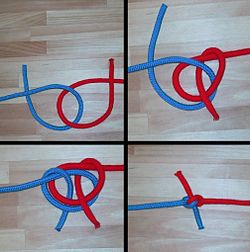| (4 intermediate revisions by the same user not shown) | |||
| Line 1: | Line 1: | ||
| − | + | {{Knot-details | |
| + | | name= Hunter's bend | ||
| + | | image= Hunters_Bend_Final.jpg | ||
| + | | names= Rigger's bend | ||
| + | | type= bend | ||
| + | | strength= | ||
| + | | origin= | ||
| + | | related= [[Overhand knot]], [[Zeppelin bend]] | ||
| + | | releasing= | ||
| + | | strength= | ||
| + | | uses= | ||
| + | | caveat= | ||
| + | | abok_number= | ||
| + | }} | ||
| − | '''Hunter's bend''' | + | The '''Hunter's bend (aka Rigger's bend)''' is a [[knot]] used to join two lines. It consists of interlocking [[overhand knot]]s, and can jam under moderate strain. It is topologically similar to the [[Zeppelin bend]]. |
| + | |||
| + | ==History== | ||
| + | Hunter's bend is one of the most recent knots to be discovered. It appeared on the front page of ''[[The Times]]'' in 1978 and was credited to Dr. Edward Hunter. Dr. Hunter used it for years to tie broken shoelaces before discovering its originality through a friend in the 1970s. When it appeared on the front page, it led to much publicity for the knot and also to the foundation of the [[International Guild of Knot Tyers]]. However, the knot was presented in '''''Knots for Mountaineering''''' by Phil Smith ca. 1956. | ||
| + | |||
| + | ==Tying== | ||
| + | [[Image:Hunters Bend HowTo.jpg|left|200px]] | ||
| + | |||
| + | <br clear="all" /> | ||
| + | |||
| + | ==External link== | ||
| + | [http://www.scoutingresources.org.uk/knots_bendshunters.html Alternative steps to tie a Hunter's Bend] | ||
| − | |||
| − | |||
{{knot-stub}} | {{knot-stub}} | ||
| − | |||
| − | |||
Revision as of 00:25, 5 June 2007
The Hunter's bend (aka Rigger's bend) is a knot used to join two lines. It consists of interlocking overhand knots, and can jam under moderate strain. It is topologically similar to the Zeppelin bend.
History
Hunter's bend is one of the most recent knots to be discovered. It appeared on the front page of The Times in 1978 and was credited to Dr. Edward Hunter. Dr. Hunter used it for years to tie broken shoelaces before discovering its originality through a friend in the 1970s. When it appeared on the front page, it led to much publicity for the knot and also to the foundation of the International Guild of Knot Tyers. However, the knot was presented in Knots for Mountaineering by Phil Smith ca. 1956.
Tying

